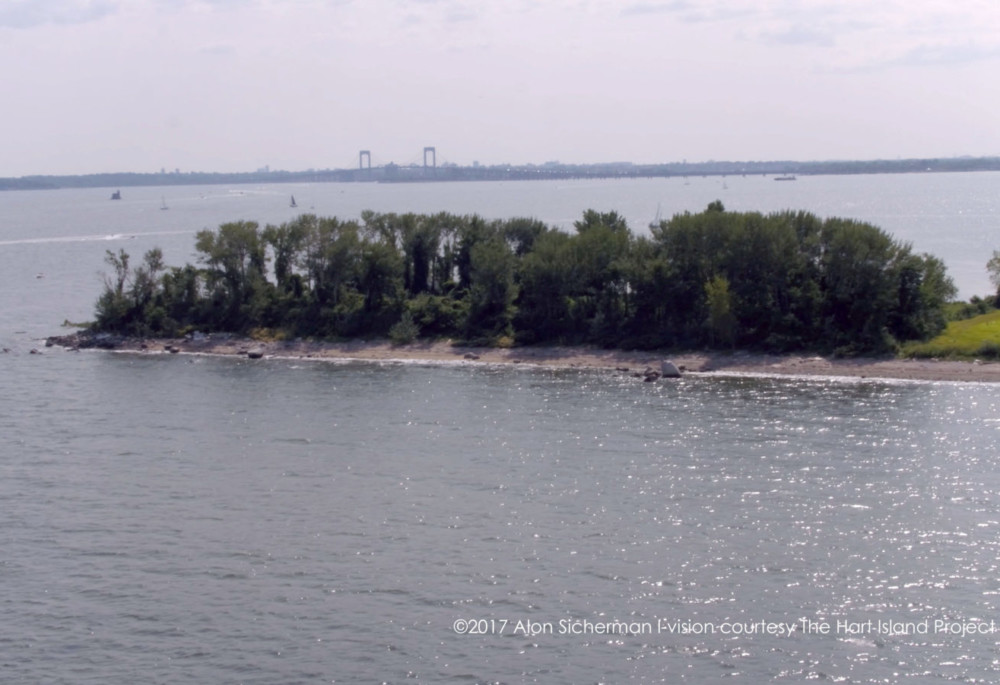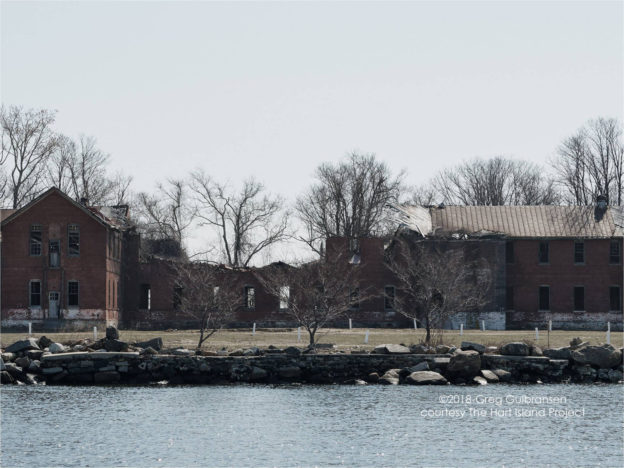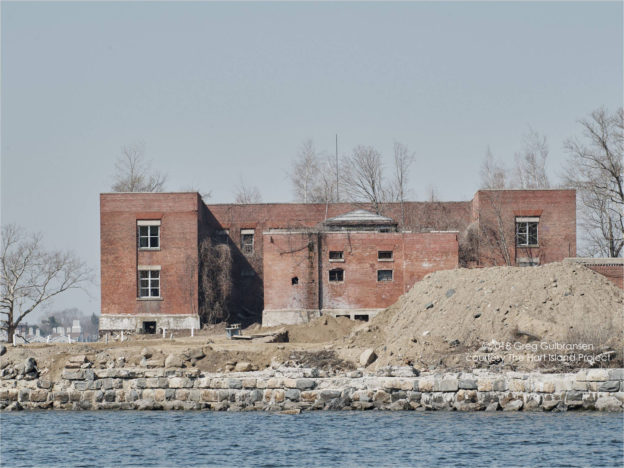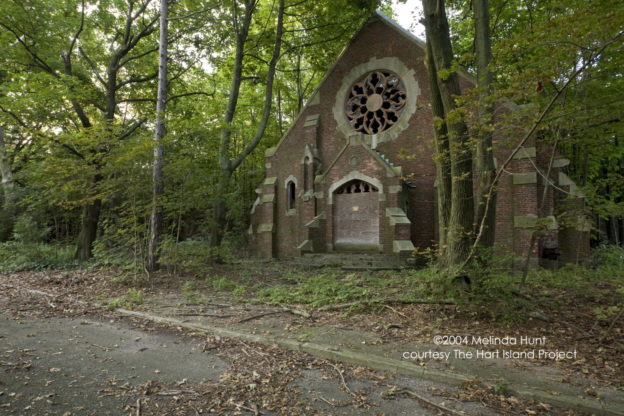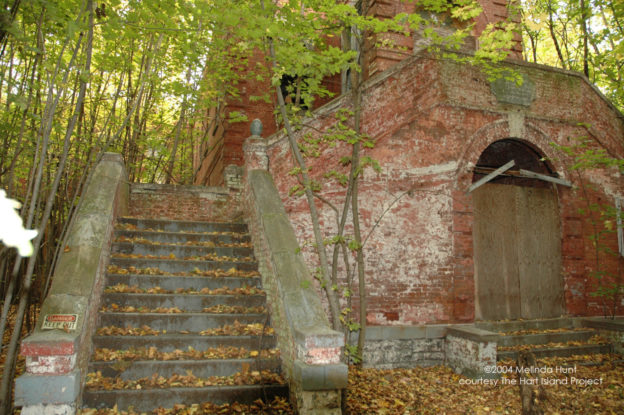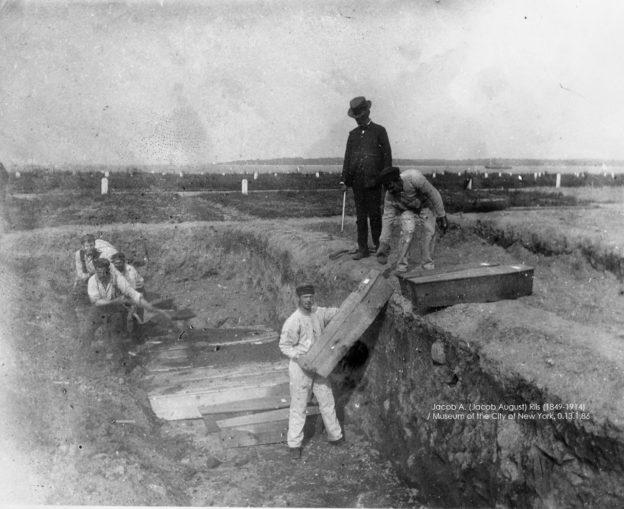1925 and 1981-85, respectively
In the early 20th century, the City owned all but four acres of Hart Island. Those four acres on the southern tip of the island belonged to John Hunter, a member of the same family that sold the larger portions of the island to the City in 1868. Hunter offered to sell the four acres to the City in 1922, but the City passed on the offer, so he sold the acres to Solomon Riley, a millionaire and Harlem developer, for $35,000 in 1924. Riley announced plans in 1925 to open an amusement park on Hart Island for Harlem blacks, who were not permitted to visit amusement parks in nearby Rye and Dobbs Ferry. The planned amusement park became known as “Negro Coney Island.” According to The New York Times, “Mr. Riley’s workers constructed a dance hall, eight boardinghouses, and a 200-foot boardwalk, and converted an old ice boat into a bathing pavilion. In June, Mr. Riley announced plans to buy a fleet of 60 motorboats to ferry customers from the mainland. Corrections officials cringed, suddenly afraid that the park would invite escape attempts, smuggling and unrest among the prison population…” So, to prevent Riley from progressing further, the City acquired the property by condemnation and purchased it from him for $144,000. The City then demolished the buildings and used the land for a sewage treatment facility. The location later became the burial site for sixteen AIDS victims who died in 1985.
Image ©2017 Alon Sicherman l-vision courtesy The Hart Island Project
date unknown
The first burial on Hart Island was that of Louisa Van Slyke, who died at age 24 from tuberculosis. In the 20th century, this building housed tubercular and chronically-ill patients. Starting in 1950, it was used to house homeless men suffering from alcohol addiction. The Committee on Alcoholism of the City’s Welfare and Health Council set up a clinic to provide physical and mental rehabilitation as an alternative to multiple short stays for disorderly conduct on Rikers Island. The clinic had space for 2,000 patients plus medical staff. In 1952, the City set up a court for alcoholics on Rikers Island and sentenced men to undergo treatment for one to six months on Hart Island. From 1967 to 1976, the building was used by Phoenix House for drug treatment under the Rockefeller Drug Laws. Judges could commit addicts to medical treatment on Hart Island for up to five years. A phoenix can be seen painted on the side of the building. Phoenix House was ordered to vacate Hart Island in 1976 after ferry service was reduced during the city’s fiscal crisis.
Image ©2018-Greg Gulbransen courtesy The Hart Island Project
c. early 20th century
Early in the 20th century, these red-brick buildings replaced the Civil War-era barracks where workhouse inmates resided. The buildings were designed without bars, offering an alternative approach to that of Blackwell’s Penitentiary on Roosevelt Island. Young men convicted of misdemeanors who resided on Hart Island were required to work as part of their rehabilitation. They were instructed in “useful trades” such as ironwork, shoemaking, landscaping, agriculture and burying the dead. Workhouse records were kept in a guardhouse facing a U-shaped cell block. The facility closed in 1966 and the inmates moved to Rikers Island, but in 1982, Mayor Koch re-opened a work camp on Hart Island of about 50 inmates who were tasked with restoring the buildings damaged by vandals. They resided in the Nike base military barracks. In 1985, residents of City Island filed a lawsuit preventing the DOC from reopening a prison on Hart Island, so the inmates left and the land formerly reserved for institutions became burial grounds.
Image ©2018 Greg Gulbransen courtesy The Hart Island Project
c. 1935
Regarding a new chapel on Hart Island, The New York Times was quoted on October 26, 1931:
“The cornerstone of the new Catholic Chapel at the Hart’s Island prison, the only separate prison building set aside for Catholic services, was laid yesterday afternoon…prisoners numbering about 1000 were grouped at the rear of the crowd…The new chapel will cost about $60,000, which is being raised by voluntary subscription under the direction of Cardinal Hayes and Father Zema.” By the time it was completed, the Hart Island Chapel cost Catholic Charities roughly one million dollars, a large sum in the Depression years. The one-and-a-half story, red brick building was abandoned in 1966, when the Hart Island workhouse closed. The stained glass was removed by the Catholic Diocese and the church bell was stolen by vandals, but the structure itself still stands in surprisingly good condition.
Image©2004 Melinda Hunt courtesy The Hart Island Project
1912
Following a review in 1904, the City Council passed legislation to build a new reformatory for “youthful offenders,” young men ages 16-30. This measure involved removing older male prisoners from Hart Island and erecting new buildings unlike conventional prison structures, as well as remodeling existing structures using inmate labor. This group of buildings, completed in 1912, provided power and a source of employment for young men living in the reformatory. They worked shifts in the laundry, cared for farm animals and harvested food grown on Hart Island that was consumed locally and distributed to City Hospitals. There was shoe making and ironwork training. Hart Island depended on coal deliveries by boat and water piped in from the mainland but was otherwise self-sufficient. This physical plant operated until 1976, when drug treatment center Phoenix House was ordered to vacate Hart Island.
Image©1992 Joel Sternfeld courtesy The Hart Island Project
1885
When the Department of Charities and Correction was formed in 1860, it greatly expanded the city’s healthcare- and reform-oriented penal institutions. The Pavilion on Hart Island was one of several lunatic asylums and charity hospitals at various locations in the greater New York area, and today it is the only 19th century building still standing on Hart Island. It was one of the first asylums constructed during Thomas Brennan’s time as Commissioner after he opened the morgue at Bellevue Hospital. Thus, the structure stands as a reminder of the island’s relationship to Bellevue Hospital. At the time, there was precedent for institutions relating to the healthcare and penal systems to be positioned in proximity to one another and to places of burial. In the 18th century, City Hall Park in lower Manhattan was host to an almshouse, gaol, workhouse and dispensary, as well as a burial ground.
Image©2004 Melinda Hunt courtesy The Hart Island Project
est. 1869
The first municipal burial on Hart Island took place on April 20, 1869, and was performed by a team of convicts from the Blackwell’s Penitentiary Workhouse on present-day Roosevelt Island (Blackwell’s Penitentiary closed after Rikers Island opened in 1927). Nearly 150 years later, the burials on Hart Island are still performed by inmates assigned by the DOC. After the Civil War, Thomas Brennan, Commissioner of the Department of Charities and Correction and Warden at Bellevue Hospital, set up the first municipal morgue in North America and adopted the Civil War practice of photographing bodies not identified by a medical examiner. Families could review photographs at Bellevue and identify their relatives and request return of their remains. At first the “unknown” were buried in individual graves and the “unclaimed” in large trenches. The enormity of these common graves made disinterment difficult, so a grid system was introduced in 1872, which is largely unchanged today. Each plot is numbered and marked, now using GPS, but previously with wood or cast concrete markers. The system was developed on battlefields during the Civil War, allowing for later disinterment should a family come forward to claim a body. In 1931, New York City began recycling graves over 50 years. This was later changed to over 25 years old, at which point the City is no longer obligated to return remains to family members. Because the graves can be reused, New York City has a sustainable system with no shortage of space for public burials. In May 1989, public burials expanded to the southern part of Hart Island formerly reserved for penal and healthcare facilities.
Image: Jacob A. (Jacob August) Riis (1849-1914) / Museum of the City of New York. 0.13.1.86
c. 1878
When the City purchased Hart Island in 1868, part of the property was to be used for a workhouse and industrial school for delinquent boys from the House of Refuge on Randalls Island. Additionally, a commercial ship, the Mercury, was to be converted to a naval vessel and used as a nautical school or “school ship” to teach the boys navigational skills. The school was managed by the Department of Charities and Correction from 1869 to 1875. The short-lived program ended in part due to lack of funds following the financial panic of 1873 and following the drowning deaths of two boys just off Hart Island, for which this memorial, the oldest on Hart Island, was dedicated. The memorial is located on the rise of “cemetery hill” overlooking the oldest part of City Cemetery. It was described in 1878 by The New York Times as “a shapely cross made by laying upon the ground white pebbles from the sea-shore…On each side of the stone cross is a little grave…In each of these lonely graves lies a little sailor boy. When the school-ship Mercury lay off Hart’s Island, not long ago, two of her little sailors died, and they were laid, messmates on ship-board, side by side in the grave, as if they had gone into that dismal pit hand in hand…” The cross now has white painted boards within the outline of white painted river stones. The memorial stands as a reminder of both the workhouse and the Mercury school ship program, and illustrates the connection between the burial process and the young men required to work in custody of the DOC.
Image©2004 Melinda Hunt courtesy The Hart Island Project
1948
During World War II, Hart Island was used as a disciplinary camp for Navy, Coast Guard and Marine personnel. Three German prisoners of war captured from a U-boat that surfaced in the Long Island Sound were imprisoned on Hart Island. After the war, ten acres at the northern end of the island were taken over by the U.S. Army. The DOC simultaneously used the area for burials, and inmates petitioned for permission to build a peace monument at the island’s highest point. In 1948, they built a 30-foot reinforced concrete memorial with the word “peace” written on one side and a simple cross on the other. The monument is elevated on a stepped base decorated with planters. This area was previously the location of Civil War-era barracks that were repurposed as prison facilities by the City. These structures are long gone except for a cistern exposed in 2012 as a result of Superstorm Sandy on a steep bank northeast of the Peace Monument.
Image©2004 Melinda Hunt courtesy The Hart Island Project
c. 1950s
During the late 1950s, the U.S. Army Corp of Engineers was tasked with construction of the nation’s first anti-aircraft missile defense, the Army’s Nike System. The weapon itself, the Nike Ajax, was the first surface-to-air guided missile placed into service in the United States when it became operational in 1953. The missile was named after Nike, the Greek Goddess of Victory, and Ajax, a fleetfooted hero of the Trojan War, and was characterized as “a finned cylinder 12 inches in diameter and 20 feet long, fired by a booster rocket that could travel at supersonic speed for a range of approximately 25 miles.” The Launch Area included two underground storage magazines with elevators to lift the m¬issiles onto launching racks, a fueling area, a missile assembly building, a generator building and various ancillary support and service buildings. Precast concrete planks now cover the remaining elevators and a concrete plug was recently installed over the hatchways to prevent access to the underground magazines.
Image©2017 Alon Sicherman l-vision courtesy The Hart Island Project
